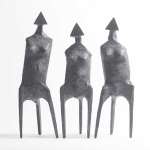Lynn Chadwick British, 1914-2003
Three Standing Figures (C67), 1987
Bronze
33 x 32 x 30 cm each
13 x 12 5/8 x 11 3/4 in
13 x 12 5/8 x 11 3/4 in
Edition 6 of 6
Further images
-
(View a larger image of thumbnail 1
)

-
(View a larger image of thumbnail 2
)

-
(View a larger image of thumbnail 3
)

-
(View a larger image of thumbnail 4
)

-
(View a larger image of thumbnail 5
)

-
(View a larger image of thumbnail 6
)

-
(View a larger image of thumbnail 7
)

-
(View a larger image of thumbnail 8
)

'Three Standing Figures', 1987 is an excellent example of Lynn Chadwick's eloquent approach to the figure. Made during the latter part of his career it is Instantly recognisable with its...
'Three Standing Figures', 1987 is an excellent example of Lynn Chadwick's eloquent approach to the figure. Made during the latter part of his career it is Instantly recognisable with its signature Chadwick triangular faces and mass resting on delicate legs. Referencing the classical theme of the Three Graces the figures are able to be arranged by the viewer in various orientations but the one Chadwick preferred was for the smaller figure to be central with the two larger figures arranged side by side almost protecting the central one.
Lynn Chadwick came to sculpture through unconventional means initially working as an architectural draughtsman. He began his sculptural career making mobile constructions for building trade fairs and it was the resulting success of these early mobiles and stabiles two of which were shown on the South Bank during the Festival of Britain in 1951, that first allowed him to seriously consider becoming a freelance sculptor.
Chadwick’s unique approach to making sculpture was based on construction rather than modelling. First, he welded a linear armature or skeleton onto which he applied a skin, building up the surface to a solid form. By beginning with an abstract form or ‘space frame’ and investing it with an allusive vitality Chadwick’s working process is the reverse of most traditional approaches. The results are equally as original and each work has a carefully considered ‘attitude’ communicated through stance, texture and finish.
Chadwick first came to international prominence in 1952 when he was included in the British Council’s 'New Aspects of British Sculpture' exhibition for the XXVI Venice Biennale alongside Kenneth Armitage, Reg Butler, Bernard Meadows, Geoffrey Clarke, Robert Adam, William Turnbull and Eduardo Paolozzi. The following year he was one of the twelve semi-finalists for the Unknown Political Prisoner International Sculpture Competition and went on to win the International Prize for sculpture at the 1956 Venice Biennale, beating Giacometti. Many honours and awards followed this period and his work was widely collected both privately and by major institutions globally. In 1964, he was awarded a CBE and in 2001 was elected a Royal Academician. A major retrospective of his work was held at Tate Britain, London in 2003.
Lynn Chadwick came to sculpture through unconventional means initially working as an architectural draughtsman. He began his sculptural career making mobile constructions for building trade fairs and it was the resulting success of these early mobiles and stabiles two of which were shown on the South Bank during the Festival of Britain in 1951, that first allowed him to seriously consider becoming a freelance sculptor.
Chadwick’s unique approach to making sculpture was based on construction rather than modelling. First, he welded a linear armature or skeleton onto which he applied a skin, building up the surface to a solid form. By beginning with an abstract form or ‘space frame’ and investing it with an allusive vitality Chadwick’s working process is the reverse of most traditional approaches. The results are equally as original and each work has a carefully considered ‘attitude’ communicated through stance, texture and finish.
Chadwick first came to international prominence in 1952 when he was included in the British Council’s 'New Aspects of British Sculpture' exhibition for the XXVI Venice Biennale alongside Kenneth Armitage, Reg Butler, Bernard Meadows, Geoffrey Clarke, Robert Adam, William Turnbull and Eduardo Paolozzi. The following year he was one of the twelve semi-finalists for the Unknown Political Prisoner International Sculpture Competition and went on to win the International Prize for sculpture at the 1956 Venice Biennale, beating Giacometti. Many honours and awards followed this period and his work was widely collected both privately and by major institutions globally. In 1964, he was awarded a CBE and in 2001 was elected a Royal Academician. A major retrospective of his work was held at Tate Britain, London in 2003.
Provenance
From the artist's estateExhibitions
Masterpiece Art fair, London 2019.Join our mailing list
* denotes required fields
We will process the personal data you have supplied in accordance with our privacy policy (available on request). You can unsubscribe or change your preferences at any time by clicking the link in our emails.







